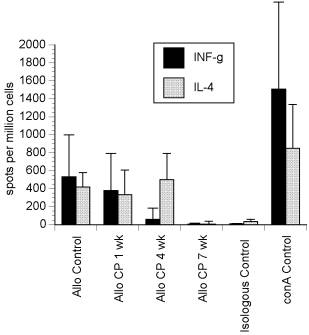Monday, October 11, 2004 - 2:15 PM
6571
PSEF 2003 Research Fellowship - Mercedes Benz, USA Award: The Effect of Cold Preservation on Nerve Allografts
Purpose: Cold preservation of peripheral nerve grafts in University of Wisconsin Organ Preservation (UW) solution has been shown to alter the immunogenicity of nerve allograft tissue. These cold preserved nerves did, however, maintain their intricate basal lamina microstructure and laminin, an important extracellular membrane component, also remained intact, thus a cold preserved nerve allograft could produce a non-immunogenic ‘ideal nerve graft’ for reconstruction of short nerve gaps. The goal of this study was to determine if progressive periods of cold preservation in UW solution will diminish the immunogenicity of nerve allografts and maintain nerve regeneration across short nerve grafts.
Methods: One, 4 and 7 week cold preserved allografts were compared to untreated allografts and isografts. See Table 1. To assess the immunologic response, C57 recipient mice received the appropriate inlay sciatic nerve graft (Balb/c donor for allografts). At 10 days, nerve tissue, the spleen and blood were harvested. Nerve tissue was examined for degree of cellular infiltration. The cellular immune response was quantified using the enzyme-linked immunosorbent spot assay (ELISPOT) and the humoral response was evaluated by measuring for donor-specific antibodies using flow cytometry. To assess the functional and histomorphometric effects, Lewis rats underwent tibial nerve grafting (ACI donor for allografts), serial walking track analysis and harvest of nerve tissue with subsequent evaluation at nine weeks.
Results: ELISPOT showed a shift from an ING-γ producing cellular response (untreated allografts) to an absence of response (7 week cold preserved allografts and untreated isograft controls). See Figure 1. There were no detectable alloantibodies by flow cytometry. Histomorphometry showed robust regeneration in the isograft and 7 week cold preserved allograft, when compared to the untreated allograft recipients. See Figure 2.
Conclusion: Cold preservation of nerve allograft tissue in UW solution diminished immunogenicity while maintaining nerve regeneration and could serve as a means to produce an unlimited supply of non-immunogenic graft material for use in the reconstruction of short peripheral nerve gaps.
Table 1: Experimental Groups.
Group N* Transplanted Nerve Tissue
I 16 Untreated Isograft
II 16 Untreated allograft
III 16 1-week cold preserved allograft
IV 16 (15)+ 4-week cold preserved allograft
V 16 7-week cold preserved allograft
*The N (number of animals per group) of 16 shown in the table includes both the 8 mice per group enrolled for the immunological analysis and the 8 rats per group to be enrolled for the histomorphometric and functional analysis.
+ The number of rats enrolled in group IV was 8. At the time of nerve graft harvest, however, a dehiscence at the nerve graft suture line was noted in one rat, therefore, the number of nerves analyzed in this group was 7.
Figure 1: ELISPOT analysis showed loss of a donor-specific INF-γ dominant response with nerve allograft cold preservation.
Figure 3: Histomorphometric analysis of the distal nerve segment reveals that 7-week cold preserved allografts support regeneration equivalent to that seen in isografts.
View Synopsis (.doc format, 144.0 kb)
See more of Technology and Research
Back to 2004am Complete Scientific Program


